Agilent's control-plane analysis software is ahead of the curve
Today's carriers, accustomed to the 99.999% availability of their SONET/SDH-based fiber networks, may be somewhat hesitant to jump headlong into an all-optical network, given the newness of the technology. Many questions remain unanswered. Are these new intelligent optical devices reliable? And will the new protocols, when implemented in a real network, be robust? Will devices from multiple vendors interoperate? Dynamic optical provisioning, a much-lauded capability of all-optical networking, is a carrier's dream, but implementing such questionable technology without verifying its reliability is risky at best.
Enter Agilent Technologies Inc. (Englewood, CO), whose Optical Control Plane Analysis Software is designed specifically for developers of intelligent optical equipment and networks to test the conformance, interoperability, and performance of new hardware and software. Agilent claims the product is the first to provide "in-band" testing of optical control-plane protocols, the first to test the new Optical Domain Service Interconnect protocols, and the first to be Multiprotocol Lambda Switch (MPlS) ready. The cornerstone of Agilent's Optical Routing Test Solution family, the new software may be used to:
- Test optical switches, wavelength routers, terabit Internet Protocol (IP) routers, ATM switches, and SONET/SDH add/drop multiplexers.
- Test the interoperability between devices and protocols from multiple vendors.
- Troubleshoot core optical networks during installation, maintenance, and field services.
- Accelerate the development and integration of optical control-plane software.
To alleviate this problem, the Optical Internetworking Forum (OIF) is currently working on standardizing optical control plane protocols, including (MPlS), a set of protocols based on Multi protocol Label Switching currently used in the IP domain. The competition among vendors to get their own equipment and protocols accepted as the standard is delaying the process, prompting Shekar Gopalan, director of consulting at market researcher Frost & Sullivan (Mountain View, CA), to predict that universal standardization is at least a couple of years away.
The Agilent Optical Control Plane Analysis Software overcomes this limitation by enabling developers of intelligent optical devices to capture and decode optical control-plane protocols across multiple ports. Proprietary and unknown protocols, unrecognized messages, and incorrectly formed message elements are converted and displayed in hexidecimals, enabling easier detection of errors and interoperability problems.
The Agilent software also enables in-band protocol testing. New optical protocols, in the SONET/SDH frame, are not carried within the payload; rather, they are carried in the small bandwidth control channel within the unused overhead bytes, which benefits carriers because they don't have to dedicate a whole wavelength to carry the protocols. Protocols detected within the in-band control channel are captured by Agilent's equipment and decoded through the protocol layers to enable developers to identify problems at any layer within the protocol stack.
So is there a ready-made market for this kind of test equipment, or is Agilent jumping ahead of the market? Carriers have invested billions of dollars in traditional SONET/SDH networks and are understandably reluctant to replace them overnight. The shift to all-optical networking will be gradual and is partially contingent on the OIF's adoption of universal protocols."With the projected rate of growth in data traffic and the convergence of voice and multimedia applications, there is no question that there is going to be a very great demand for dynamic allocation of bandwidth," says Gopalan. Despite increasing demand for scalable bandwidth, however, widespread deployment of intelligent optical networks may be an additional "three to five years down the line," he admits, which doesn't necessarily mean that Agilent's software will sit on the shelf and collect dust until then. Gopalan is quick to note that developers currently working on intelligent optical switches and prototypes would clearly benefit from the capabilities provided by Agilent's software."The initial market will be there," he says, "but maybe not at the very high level in terms of installation in the field. That market is at least 18 to 24 months away."Agilent's initial market includes Tellium Inc. (Oceanport, NJ), which has been using a pre-released version of the software for several months now. John Nakulski, lead product manager for the new test equipment family, recognizes that the product is a long way from deployment but isn't worried about a lack of market demand.The Optical Control Plane Analysis Software enables those people "building the equipment to get the pieces built faster, to assemble those pieces faster, and to get their products to market," says Nakulski. "[This] means the carriers are going to have products to choose from that will actually do what they want them to do sooner. Our role is to act as a catalyst to speed these cycles up by giving people the tools that enable the developers to work more efficiently."






